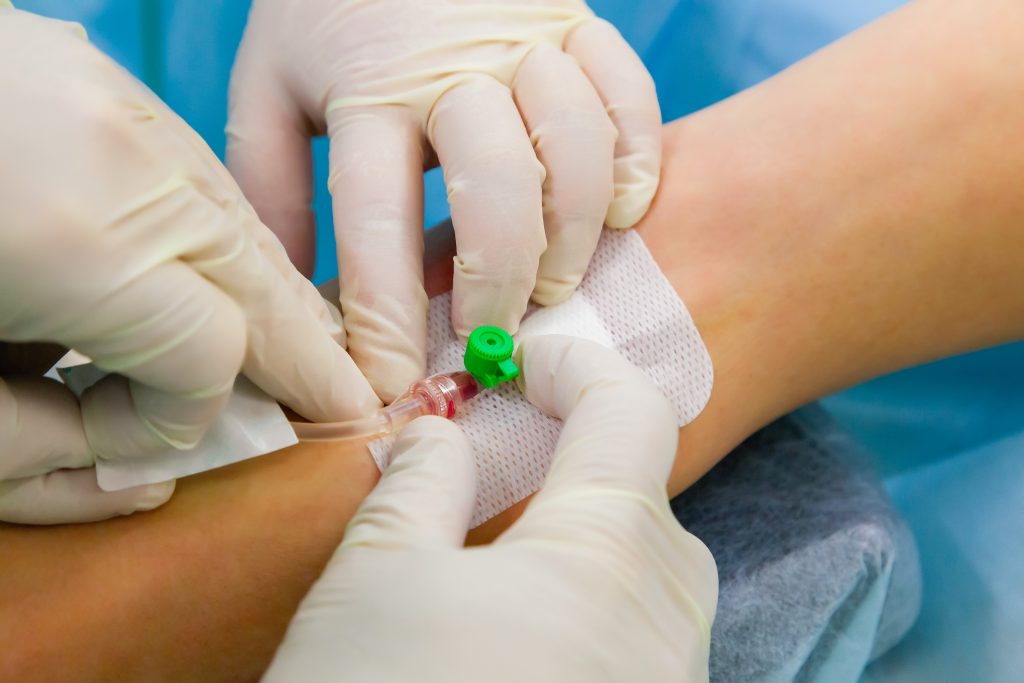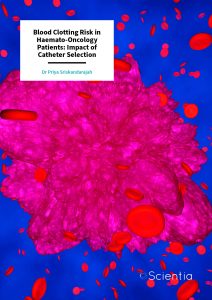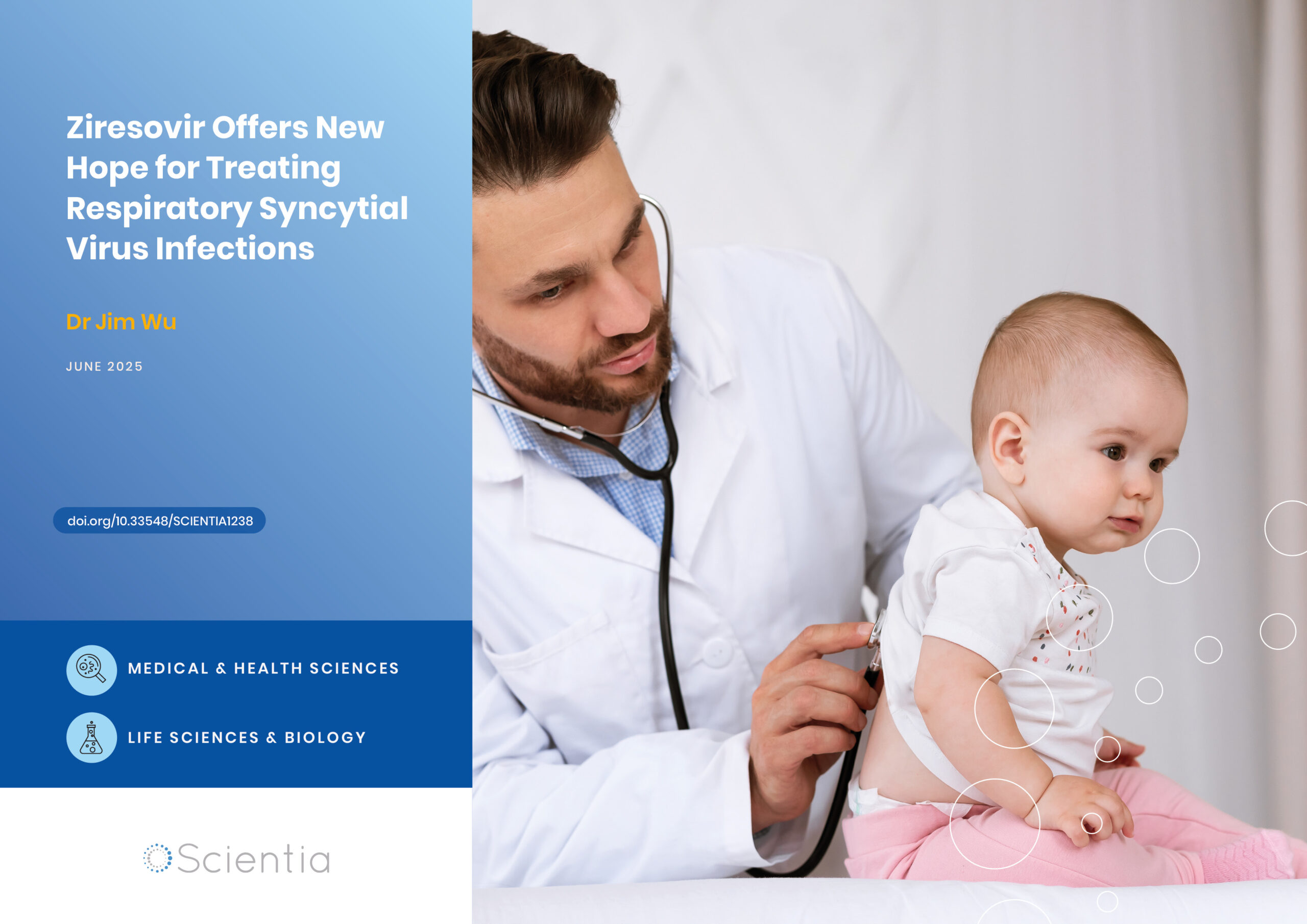Dr Priya Sriskandarajah | Blood Clotting Risk in Haemato-Oncology Patients: Impact of Catheter Selection
Venous catheters are an important medical tool, enabling haemato-oncology patients (i.e., those with blood cancers) to receive vital chemotherapy. However, there is the risk of thrombosis, more commonly known as blood clotting, particularly with peripheral catheters. Dr Priya Sriskandarajah, a consultant haematologist, retrospectively analysed patients’ medical records to study the implications of catheter selection in this group of patients.
Venous Catheters in Cancer Care
There have been breathtaking advances in cancer treatment in the past century. Also important are the supportive technologies enabling efficient treatment administration, such as venous catheters. A catheter is a tube device (a ‘line’) surgically inserted into a patient’s vein, allowing medication or nutrition to be administered via intravenous infusion. This is necessary for patients who are unable to eat normally or for the delivery of medication while bypassing the digestive system. Catheters have revolutionised cancer care, allowing the passage of chemotherapy directly into the bloodstream. However, they are not without risk. Catheters provide some resistance to blood flow and may lead to thrombosis (blood clotting).
There are two main types of catheters – long-term skin tunnelled catheters (LTSTCs) and peripheral catheters (PICC – pronounced ‘pick’). An LTSTC is surgically tunnelled under the skin into a central vein (usually in the chest) with separate insertion and exit sites, and may remain in place for several months. A PICC is an external catheter connected to a peripheral vein, usually in the arm. PICCs are less invasive and are more easily installed. Haematologists and oncologists must consider the various risk and benefit factors when deciding whether to insert an LTSTC or PICC catheter.
Investigating Thrombotic Impacts of Catheter Selection
Dr Priya Sriskandarajah is a consultant haematologist with a special interest in catheter selection in the clinical practice of haemato-oncology – the field of ‘blood cancers’. Patients with haematological cancers often require long-term intravenous access for blood products, chemotherapy, or stem cell rescue. In UK hospitals, PICCs are typically used for first-line chemotherapy. As they are less invasive than LTSTCs, they are not as susceptible to mechanical complications. LTSTCs are used for stem cell rescue. However, the increasing recognition of catheter-related thromboses is challenging this status quo. Haemato-oncology patients often take anticoagulant medication to thin the blood and reduce the risk of blood clots.
Dr Sriskandarajah led a pivotal cohort study into the risk of catheter-related thrombosis at the Royal Marsden Hospital, UK. Her team analysed medical records of patients with haematological cancers who were admitted and had a PICC or LTSTC line inserted. After insertion, patients underwent duplex ultrasound assessment to detect the presence of thromboses. The team reviewed patients’ ultrasound reports, as well as their demographics, medical histories, and treatment plans.
Records of 583 patients were retrospectively analysed – of these, 346 patients received a PICC and 237 received an LTSTC. The haematological cancers included acute myeloid leukaemia (AML), acute lymphoblastic leukaemia, Hodgkin or non-Hodgkin lymphoma, multiple myeloma (MM), and chronic lymphocytic leukaemia. There was a higher number of patients with AML receiving a PICC than an LTSTC. In contrast, there was a higher number of patients with MM who received an LTSTC compared to a PICC.

Increased Risk and Secondary Complications with PICC Catheters
There was a greater cumulative incidence of catheter-related thrombosis with a PICC than with an LTSTC. During follow-up, about 1 in 20 patients receiving a PICC (5.6%) developed thrombosis vs 1 in 50 patients (1.7%) receiving an LTSTC, a statistically significant difference. Thromboses usually occurred early in treatment. Within 30 days after insertion, catheter-related thrombosis was reported in 5% of patients with a PICC and 1% of patients with an LTSTC.
The ‘dwell time’ of a catheter line refers to the duration of its placement within a patient’s vein. Typically, LTSTCs are inserted for longer than PICCs, and this was confirmed in the current study. The median dwell time for LTSTCs was almost twice as long as for PICCs (109 days vs 65 days). The risk of thrombosis increased the longer a PICC or LTSTC was inserted. After 6 months, deep vein thrombosis (DVT) was reported in 14% of patients with a PICC. For comparison, DVT was reported in 6% of patients with an LTSTC after 27 months. Thus, thrombosis risk increased at a slower rate with an LTSTC than with a PICC despite longer dwell times with an LTSTC.
Thrombosis can lead to complications that can delay a patient’s treatment plan. Thus, secondary complications were assessed in patients who experienced a catheter-related thrombosis. Patients with a PICC had more than double the risk of a catheter infection than those with an LTSTC (45% vs 20%). Following a catheter-related thrombosis event, 80% of patients had their PICC removed, compared with 50% of patients who had their LTSTC removed. All patients who developed a catheter-related thrombosis received an anticoagulant medication for 3 months. All the patients who received the anticoagulant had a normal platelet count, and no haemorrhage-related complications were reported.
Risk Factors for Catheter-Related Thrombosis
Dr Sriskandarajah and her team also considered the risk factors in patients who developed catheter-related thrombosis. These data were available for 20 patients with a PICC and four patients with an LTSTC. A venous thromboembolism (VTE) is a large clot that blocks blood flow in a vein. A history of VTE was reported in two patients with a PICC (10%), compared with no patients with an LTSTC. Given the small number of patients, it is not surprising that this difference was not statistically significant, but it does suggest that VTE history is a contributing factor for PICC-related thromboses. Patients with a PICC or LTSTC were equally likely to receive immunomodulatory drugs (10%) and an anticoagulant (10%). Rates of catheter-related thrombosis were similar between patients with newly diagnosed disease, relapsed or refractory disease, and remission (5.3% vs 6.1% vs 6.5%). Taken together, these findings suggest that the disease stage does not affect thrombosis risk.
Implications for Treatment
PICC catheters are routinely used to administer chemotherapy in haemato-oncology patients. While awareness is growing around the risk of PICC-related thrombosis, the literature is somewhat limited. Dr Sriskandarajah’s study is the largest to investigate the real-world impact of catheter selection. The finding of a greater risk of catheter-related thrombosis with PICCs than with LTSTCs, leading to a higher rate of thrombosis-related complications with PICCs, is critical. By analysing the potential risk factors for thrombosis, Dr Sriskandarajah was able to confirm that a history of VTE is likely a contributing factor in patients with PICCs.
In terms of clinical practice, Dr Sriskandarajah argues that the risk of thrombosis must be taken into account in catheter selection. This is particularly true when long-term chemotherapy is needed or when patients have a history of clotting. Clearly, patients must be continuously monitored, particularly those at higher risk. Finally, Dr Sriskandarajah’s research raises the important question of whether haemato-oncology treatment plans should include systemic anticoagulants to prevent thromboses.
SHARE
DOWNLOAD E-BOOK
REFERENCE
https://doi.org/10.33548/SCIENTIA988
MEET THE RESEARCHER

Dr Priya Sriskandarajah
Guy’s and St Thomas’ NHS Foundation Trust
London
UK
Dr Priya Sriskandarajah achieved her medical degree at Kings College London in 2007. She then embarked on haematology training as a National Institute for Health and Care Research Academic Clinical Fellow at the Royal Marsden Hospital while rotating at St Helier Hospital. In 2019, she obtained her PhD at the Institute of Cancer Research, examining molecular targets in RAS-mutant multiple myeloma. During her PhD, she was also a Clinical Fellow at the Institute of Cancer Research involved in Phase I trials as well as a sub-investigator on Phase III studies. In 2020, she transferred to Guy’s and St Thomas’ trust as a Clinical Fellow, where she screened and managed patients with systemic mastocytosis in Phase III clinical trials. Throughout her career, she has participated in teaching programmes for oncology fellows and junior medics, helping them gain a better understanding of the complexities of treating haematology patients.
CONTACT
E: priya.sriskandarajah@nhs.net
W: www.linkedin.com/in/priya-sriskandarajah-305ba4110
KEY COLLABORATORS
Dr Katharine Webb, Royal Marsden Hospital
Dr David Chisholm, Royal Marsden Hospital
Dr Ravi Raobaikady, Royal Marsden Hospital
Ms Natalie Lawrence, Royal Marsden Hospital
FURTHER READING
P Sriskandarajah, Webb K, Chisholm D, et al., Retrospective cohort analysis comparing the incidence of deep vein thromboses between peripherally-inserted and long-term skin tunneled venous catheters in hemato-oncology patients, Thrombosis Journal, 2015, 13, 21. DOI: https://doi.org/10.1186/s12959-015-0052-2
REPUBLISH OUR ARTICLES
We encourage all formats of sharing and republishing of our articles. Whether you want to host on your website, publication or blog, we welcome this. Find out more
Creative Commons Licence (CC BY 4.0)
This work is licensed under a Creative Commons Attribution 4.0 International License. 
What does this mean?
Share: You can copy and redistribute the material in any medium or format
Adapt: You can change, and build upon the material for any purpose, even commercially.
Credit: You must give appropriate credit, provide a link to the license, and indicate if changes were made.
SUBSCRIBE NOW
Follow Us
MORE ARTICLES YOU MAY LIKE
How Food Environments Shape Our Eating Habits
How we eat dramatically impacts our health, yet millions of Americans live in ‘food deserts’ – areas with limited access to fresh, nutritious food. Recent research reveals that solving this crisis requires looking beyond just physical access to food to understand how our entire community environment shapes our dietary choices. Through a series of pioneering studies, Dr Terrence Thomas and colleagues at North Carolina A&T State University have been investigating how different aspects of our food environment influence what we put on our plates. Their findings suggest that creating lasting change requires reimagining how communities engage with food at every level.
Dr Jim Wu | Ziresovir Offers New Hope for Treating Respiratory Syncytial Virus Infections
Respiratory syncytial virus (RSV) causes respiratory tract infections in children and adults. While for many patients the outcomes of infection are mild, for others, infection can prove fatal, and there is a lack of effective treatments. Dr Jim Wu from the Shanghai Ark Biopharmaceutical Company in China carries out his vital research to develop new, safe, and effective treatments to tackle this killer.
Dr Sandra Grumelli | The Importance of the Choline in Chronic Lung Infections
People with chronic lung conditions like COPD and cystic fibrosis are vulnerable to lung infections caused by the bacterium Pseudomonas aeruginosa. These infections are often difficult to treat and can cause sudden worsening of symptoms, known as flare-ups or acute exacerbations. While we know P. aeruginosa triggers inflammation and damage in the lungs, much less is understood about how exactly it causes these flare-ups, or how it survives in such a harsh environment. Dr Sandra Grumelli from the Center of Investigations of Respiratory Diseases in Argentina, has explored the role of a common molecule called choline which is released during infection. Using a combination of mouse models and laboratory experiments, she has discovered that choline not only makes breathing harder, it also helps P. aeruginosa adapt to and persist in the lungs. Her research opens up new possibilities for tackling chronic infections by targeting the bacteria’s energy use and the way it responds to its environment.
Can Your Personality Shield Your Mind From Ageing? How being open to new experiences might protect against cognitive decline as we age
Many of us have witnessed the troubling effects of ageing on the mind in older friends or family members – the forgotten names, the misplaced keys, the struggle to solve problems that once seemed simple. For decades, scientists have accepted cognitive decline as an inevitable part of growing older. But what if our personality could protect us from some of these changes? A remarkable 25-year study by Dr David Sperbeck, a neuropsychologist at North Star Behavioral Health Hospital in Alaska, has uncovered compelling evidence that certain personality traits might act as a shield against age-related cognitive decline.





